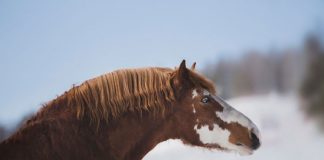
Cleanliness is next to horseliness
The vast majority of castration incisions are purposely left open for drainage instead of being sutured closed. This means that for the first few days after surgery there will be some serum and a little blood oozing from your horse (see #2 below). This discharge inherently draws flies, so fly control is of utmost importance post-gelding. Apply fly spray liberally up and down your horse’s hind legs and close to the incision (but try not to get it directly on the wound) multiple times a day. If possible, get your gelding outside in clean pasture. If he must stay in a stall, keep it impeccably clean for when he lies down. Stall fans are helpful for fly control, too.
Observing the Ooze
Like mentioned above, a gelding’s open incision is supposed to ooze for a few days after surgery. In fact, no oozing can lead to uncomfortable swelling. But what’s considered normal? A small amount of blood is acceptable within the first 12 hours of surgery. An occasional drip is perfectly fine as capillaries and small arteries continue to open and close due to movement while the tissue is healing. A stream of blood or a spurt is not normal and necessitates a call to your vet.
Within the first 24 hours, if your horse has been lying down and then gets up with a moderately sized pool of ooze left in his wake, that’s ok too. In essence, a blood-tinged discharge with the consistency and color of serum (straw-colored) is normal. Remember as blood coagulates, you may see a clot hanging from the incision—don’t panic. Many an owner has mistaken a clot for something far worse!
What’s considered abnormal ooze? Anything that is thick and yellow or greenish is definitely abnormal and signals infection. The same thing goes for anything that is foul smelling. Like with abnormal bleeding, if you see or smell something off, call your vet.
Keep it moving
Understandably, the last thing your horse may want to do after castration is actually move. And while letting him snooze off his sedation is definitely a good idea for the first few hours, don’t keep him constantly housed in a stall for the next week unless your veterinarian has specifically directed that.
One of the primary causes of post-operative pain for castrations is swelling. The best way to reduce swelling is movement. Put your horse out in a paddock or round pen 12 to 24 hours after surgery to encourage him to move. After a few days, it’s okay to put him out on pasture as long as you keep an eye on him. Sometimes even ten to fifteen minutes of walking/trotting on a lunge line is recommended for those horses that are really reluctant to stretch their legs while they recuperate.
Size matters
Despite keeping the surgical wound open for drainage and encouraging movement, a gelding will still swell post-operatively. This swelling is seen at the scrotum. Sometimes, intercellular fluid accumulates down the legs. This is called edema. Moderate swelling is expected and acceptable. This means, in the scrotal area, expect to see nothing more than about orange-sized. Anything larger than that and a call to your vet is warranted. Frequently, excessive swelling just means the incision has healed too fast, preventing drainage. Your vet will come out, make sure there’s no infection, and re-open the incision to allow drainage. Swelling will decrease after that.
When to call the vet
Excessive bleeding, stinky ooze, and massive swellings are three very common reasons to have your vet back out to re-check your gelding. Other things to monitor closely include your horse’s appetite and personality. After sedation has worn off a few hours post-surgery, he can eat hay or graze. Within 12 to 24 hours, his appetite should return to normal. If it doesn’t, or if it waxes and wanes over the next week, call your vet. Additionally, if you notice your horse acting lethargic or febrile, these are cases to have your vet back out, too.
Liked this article? Here’s more on colt care:
A Guide to Gelding
Hormones and Horse Behavior






great info
How long should it take for your horse to heal after surgery?